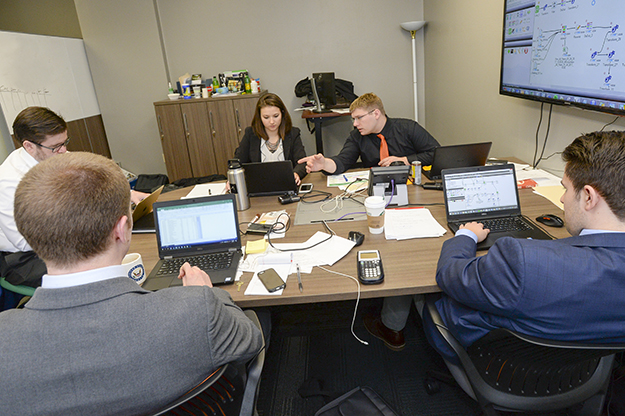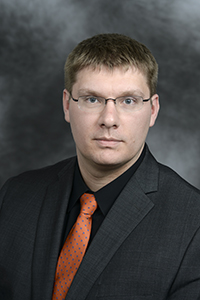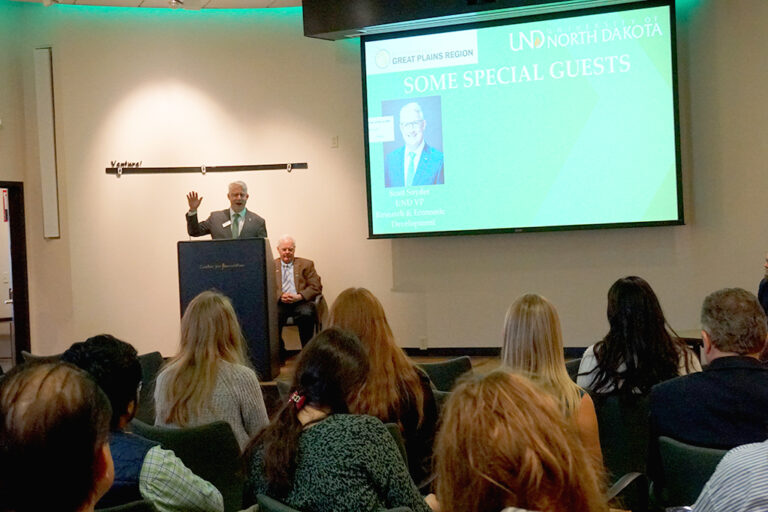Data-driven decisions
UND Office of Institutional Effectiveness uses data chops to guide Strategic Plan, clean up data and enhance student success

This July, four faces of UND’s Office of Institutional Effectiveness (OIE) plan to compete as a team in a Tough Mudder competition—an obstacle-based race filled with steep walls, water pits and, well, mud.
“I’m super pumped,” said interim OIE Director Frank Swiontek, with a touch of amiable sarcasm that drew laughs from the rest of his team.
But overcoming complicated and messy hurdles is what this quad of data wranglers does best—and those will be the skills the University of North Dakota needs in the coming months of change as the institution rolls out its new Strategic Plan and implements more data-driven decision making.
The Office of Institutional Effectiveness was born in December 2016, a move by UND Provost Tom DiLorenzo to merge the data strategy elements of the University with the traditional Institutional Research arm.
“It was to try to have consistent use of data, but also to combine both past experience and a newer, modern way of using analytics,” Swiontek said.
“It’s built on the premise that you can’t manage what you can’t measure,” Senior Data Analyst John Mitzel expanded. “Being able to effectively manage an institution has never been more important—especially when we’re in the middle of the Strategic Planning process, when we’re trying to not just survive budget cuts, but thrive in them and grow into the future.”
Partners in strategy
As the UND Strategic Planning Committee developed a draft model of the University’s core values, vision and goals over the past several months, they were tasked by President Kennedy to include SMART goals (Specific, Measurable, Achievable, Relevant, Time bound) in the process.

OIE is putting the “M” in SMART.
“The goals have to have a minimum of one metric assigned to them,” Swiontek explained. “We help provide the right metric and provide a guide to show, for example, is this goal feasible in five years? Three years? Is this an appropriate metric to gauge the success of the institution for this goal?”
Among the many items OIE will be monitoring are graduation rates, enrollment increases, and other metrics comparing UND to direct competitors and more aspirational institutions. Swiontek says they are looking into software that will allow them to map specific points and milestones within the 5-year process.
To help meet the Strategic Plan’s goal of increasing graduation rates, OIE is working with the Office of the Registrar to find and implement an electronic degree planner. UND Registrar Scott Correll says the software they are examining would be more intuitive than the static four-year plans currently found online.
“Students will be able to see where they are in their current major, or they can turn around and do a ‘what if’—what if I change my major to ‘blank,’ what do I still need to take?” Correll said.
OIE’s partnership with the Registrar is just one piece of the picture. The two offices also meet weekly with a group that includes Provost DiLorenzo, Chief Information Officer Madhavi Marasinghe, and representatives from Institutional Research and the Student Success Center.
“A lot of things that come out of the research that Institutional Effectiveness has done—some of the things that are going to be the driving factors and the action items in the Strategic Plan—rely on many offices to operationalize it,” Correll said.
“Everyone has a play in how this plan will make students successful,” Swiontek added.
Predictive analytics
Before UND can put diplomas in the hands of graduates, it has to first get students in the classrooms. Predictive analytics can help fill those seats—and UND has just recently started to harness that power.
“President Kennedy’s leadership has been very significant in getting that data created and shared with campus,” Mitzel said. “The increasing institutional focus on data-driven decision making is transforming a lot of areas.”
OIE uses predictive analytics in two main contexts. One is retention—trying to predict the success of an incoming student in his/her first year. The other is admissions. Swiontek said they can create a probability score for the students who have applied to UND, and map those scores so recruiting resources can be directed appropriately.
“If a student has a 10 percent likelihood of coming here, we probably wouldn’t deploy as many resources as we would for a student at 50 percent, where we could sway them,” Swiontek explained.
Clean data
Beyond monitoring and implementing the goals of the Strategic Plan, OIE has an additional charge—creating a consistent and usable landscape for all of the data being created on campus. Before the office was formed last year, information came in through inconsistent means—often rendering it “messy” and unusable.
“We are cleaning up the data so that we can feel comfortable with ‘One Data’ at ‘One UND,’” Provost DiLorenzo said.
Swiontek said it’s important to note that all of UND’s colleges are different, so there will always be slight data discrepancies. For example, research is conducted and recorded in a number of ways across campus. Trying to create a structure behind that information has been one of OIE’s main priorities.
“We’re hoping to work with companies like EAB (Education Advisory Board) to align our methodologies across campus to pair with an industry standard, but also to see what other colleges are doing as well,” Swiontek said. “This is a common issue in higher education.”
One UND team
The OIE foursome that shares a collaborative office space on Twamley Hall’s fourth floor has a special investment in the University—Mitzel and data analyst Dara Morehouse are both UND Applied Economics grads, and data analyst Sean Cleary is working on his UND master’s thesis.
Mitzel said through his undergraduate and graduate experience, he developed an attachment to the University. “It’s been very rewarding to have the opportunity to give back to an institution that provided me with an education that can’t be matched on value,” he reflected.
Whether they’re double-checking each other’s numbers, working through analytics roadblocks—or physically boosting each other up and over obstacles in a wet and mucky race course—the crew knows there’s safety in numbers.
“We’ve created a team environment where collaboration is essential and constructive criticism is not only accepted, but sought after,” Mitzel said. “I think that’s absolutely critical when you’re working with data that’s going to be used to make major decisions.”


